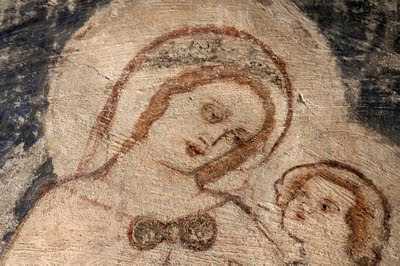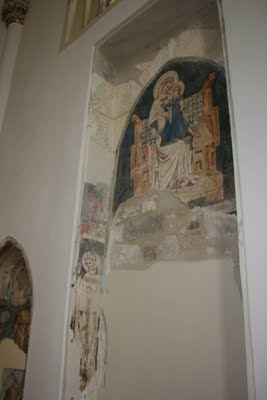Medieval History


- Most Popular Posts On Medieval Hungary
The end of the year marks the end of my third year of blogging. Along the way, I have posted 120 posts on various topics related to Hungarian medieval art, which generated over 90.000 page views to this date. My blog was featured in several online journals...
- Late 14th Century Frescoes Discovered At Nitra Cathedral
The cathedral of Nyitra (Nitra, Slovakia) is one of the oldest, most complex, and - until quite recently - least known cathedral building of medieval Hungary. Located north-east of Pozsony/Pressburg/Bratislava, the bishopric of Nyitra was founded before...
- Botticelli In Esztergom?
Temperantia Esztergom, Studiolo of palace Photo via artmagazin I did not want to write this post. A great discovery has been announced a few years ago (frescoes painted by Botticelli have been identified in Esztergom!) but I still remain skeptical....
- Hungarian Azurite
When the previously unknown fresco of the Virgin and Child was uncovered in the Inner City parish church of (Buda)Pest, the restorer and art historians alike were struck by the excellent preservation of large patches of azurite blue. The cloak of the...
- The Medieval Parish Church Of Pest (part Ii.) - A Remarkable Discovery
This post focuses on the medieval fresco decoration of the Inner City parish church of Pest - you can read my introduction to the history of the building here. Not much survived of the original painted decoration of the Inner City parish church....
Medieval History
First publications on the murals of the parish church of Pest

The 14th century fresco of the Virgin of Child, discovered last year in the sanctuary of the Inner City Parish Church of Pest (in downtown Budapest) created quite a stir. I suppose it always creates some stir when a a fresco appears older than the wall it is painted on. The sanctuary of the parish church of Pest has always been dated to around 1400, while the fresco clearly dates from some time in the 14th century. This then of course calls for a re-evaluation of the construction history of the church, something which is quite hard to do without more extensive on-site research. Already, debate is raging on concerning the date of the newly discovered frescoes (also, some questions have been raised about the restoration as well). A detailed examination of the building and all its fresco decoration, however, is yet to be carried out.
The Hungarian journal M?emlékvédelem published several articles on the building, summarizing the results of previous art historical and architectural research, also publishing restorer Éva Derdák's overview of the uncovering and restoration of the mural (M?emlékvédelem, vol. LIV, 2010/6). The journal is not available online, but you can see the contents of the issue here. Tünde Wehli wrote an article for the journal on the newly discovered frescoes. After briefly describing the frescoes, she proceeds to bring analogies to the image of the Madonna. Most of these come from the north of the Alps, from France and Central Europe (esp. Bohemia), although Wehli acknowledges the Italian origins of several motifs of the fresco (such as the shape of the throne). In the conclusion of her article, Tünde Wehli dates the fresco to the last quarter of the 14th century - a date which requires a relatively modest modification in the building's chronology.

More recently, Mária Prokopp also wrote on the frescoes. She is a noted expert of the Italian connections of Hungarian medieval painting (I wrote on her theory of Botticelli in Esztergom). Her article was published in Múzeumcafé, which is a flashy magazine about museums, and is not really known for serious studies on medieval art. Prokopp's article can be read in the online version of Múzeumcafé vol. 5, 23 (2011 június/július), and also here. A somewhat more detailed version of Prokopp's article is available in the journal Magyar Sion (2010/2, full text available here). Prokopp's study also appeared in the journal of the Budapest History Museum (Tanulmányok Budapest Múltjából 36, 2010), in what can be considered as its definitive version to this date. A pdf-version of the Hungarian-language article is available here; there is a brief German summary at the end. Prokopp cites mainly Italian analogies from the beginning of the Trecento, and thus dates the fresco of the Virgin and child to around 1320-1340 (the fresco of the bishop she considers even earlier, from the end of the 13th century). In explaining the significance of the frescoes, she analyses the historical importance of the church as well.
I've had no time to write anything more than some blog-length pieces on the fresco so far. My brief report on the find (essentially the same as my first two blog entries - see part I and part II) was summarized for the newsletter of the International Center of Medieval Art (April 2011 issue), while my report on Hungarian azurite was picked up by National Geographic Hungary (May 2011). Hopefully I'll get to write more about it soon!
- Most Popular Posts On Medieval Hungary
The end of the year marks the end of my third year of blogging. Along the way, I have posted 120 posts on various topics related to Hungarian medieval art, which generated over 90.000 page views to this date. My blog was featured in several online journals...
- Late 14th Century Frescoes Discovered At Nitra Cathedral
The cathedral of Nyitra (Nitra, Slovakia) is one of the oldest, most complex, and - until quite recently - least known cathedral building of medieval Hungary. Located north-east of Pozsony/Pressburg/Bratislava, the bishopric of Nyitra was founded before...
- Botticelli In Esztergom?
Temperantia Esztergom, Studiolo of palace Photo via artmagazin I did not want to write this post. A great discovery has been announced a few years ago (frescoes painted by Botticelli have been identified in Esztergom!) but I still remain skeptical....
- Hungarian Azurite
When the previously unknown fresco of the Virgin and Child was uncovered in the Inner City parish church of (Buda)Pest, the restorer and art historians alike were struck by the excellent preservation of large patches of azurite blue. The cloak of the...
- The Medieval Parish Church Of Pest (part Ii.) - A Remarkable Discovery
This post focuses on the medieval fresco decoration of the Inner City parish church of Pest - you can read my introduction to the history of the building here. Not much survived of the original painted decoration of the Inner City parish church....
